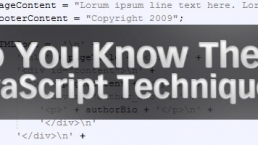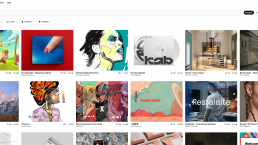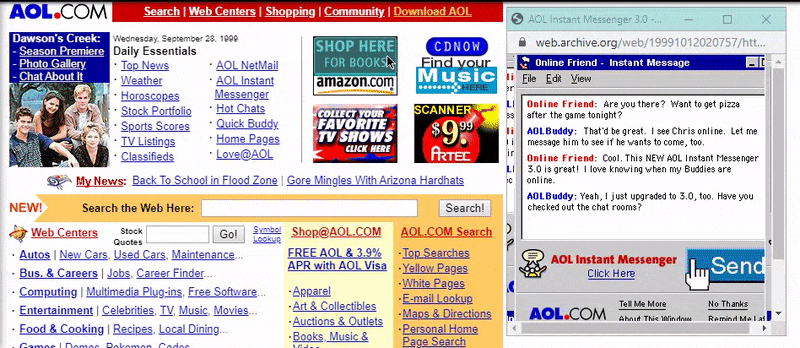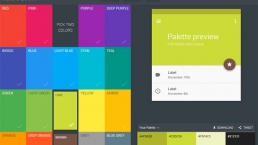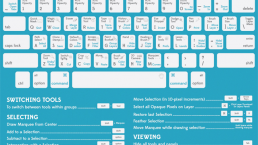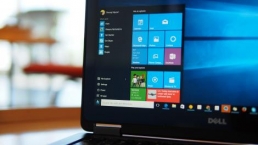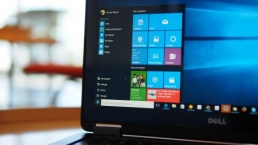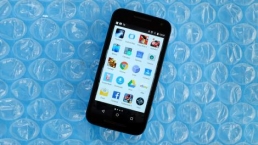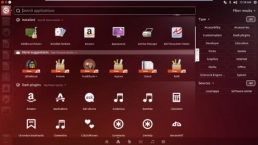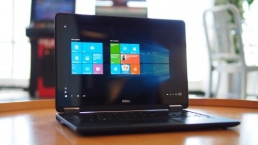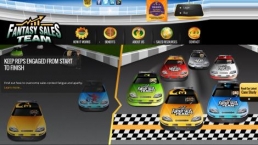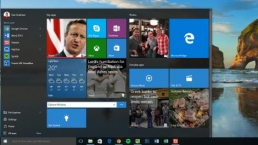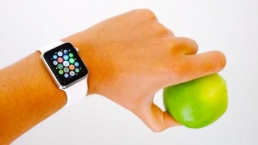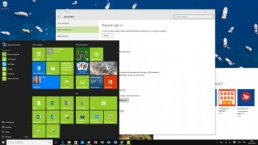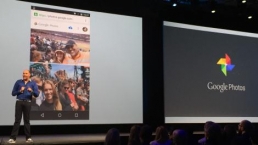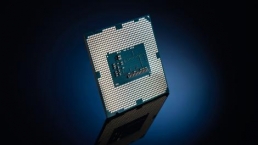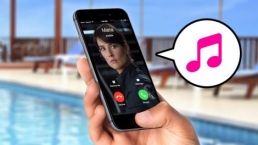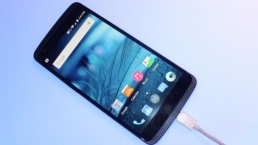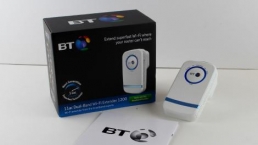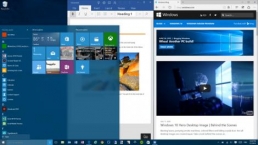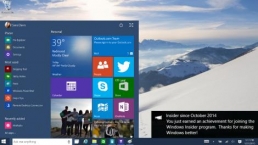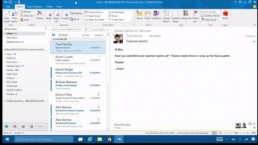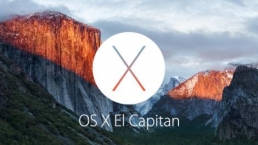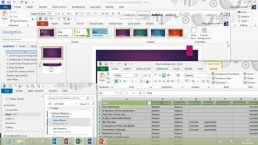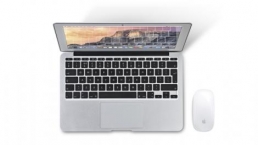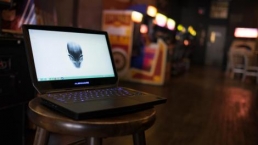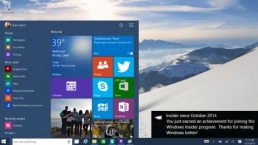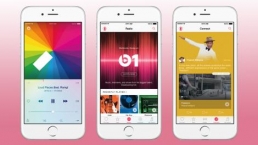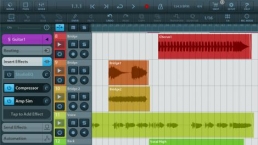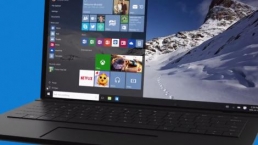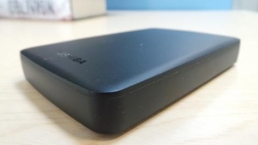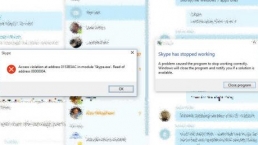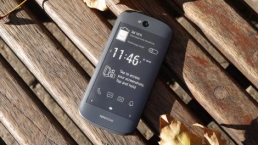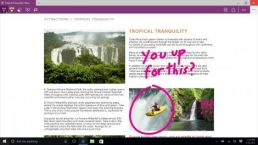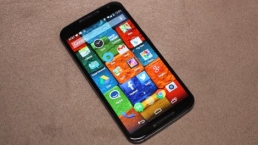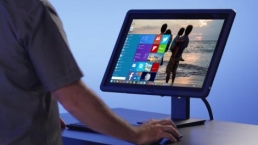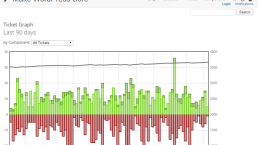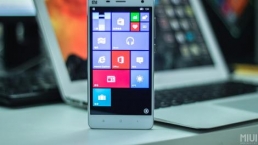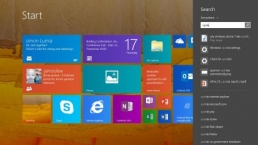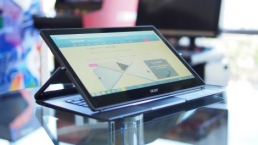
Microsoft HoloLens at Build 2015
Note: Microsoft didn’t allow any technology, including cameras, inside the Build 2015 HoloLens demo room. The images below were taken of a HoloLens inside a glass case located outside the demo room.
HoloLens, Microsoft’s AR viewer, feels like the future of computing.
The headgear I tried at Build 2015 is still described as “early development hardware,” and it definitely felt like it. But the potential and how close HoloLens is to achieving it is remarkable.
The moment I tried on HoloLens, I thought, “This is like having a PC on my face.” It’s not that fully functional yet, but that’s how the headgear and what you see and can do with it make you feel.
There were no Mars missions or Minecraft-inspired games in the HoloLens session I attended. Instead, I became a developer for 90 minutes, crafting an application in Unity and adding layers of HoloLens functionality as I went. Every time a new function was added, like gesture controls and spatial sound, I got to see how it translated into the HoloLens experience. The session was intended to show how easy it is to develop for HoloLens, but it also demonstrated what users will experience once it’s available.

How HoloLens fits
HoloLens is essentially made of two rings, a thicker one along the outside that contains all the important innards and a slimmer one on the inside that wraps around your head. The inner ring has a roller in the back to tighten and loosen it, and it slides forward and backward so you can adjust how close HoloLens is to your head. HoloLens isn’t supposed to sit on your nose, but I found the rubber nose guard that comes with it inevitably fell on my nose no matter how many times I pried HoloLens forward. Thankfully, it’s optional and comes off easily. HoloLens felt a lot better for me with it off.
I also had a hard time getting HoloLens to fit just right every time I put it on. I had to regularly re-tighten, re-situate, and realign the headgear. When everything was synced up and it fit nicely, the holograms were in full view and it felt right. But if it was too tight, too high up or too far forward, it hindered the experience. Standing in one spot and not moving too much created the best overall viewing experience. The adjustment issues cropped up especially when I was moving around, which is part of the fun when wearing HoloLens.
If you have short hair or it’s pulled back, you might not have a much of a problem as someone with long, loose hair, like myself. It may have been my unskilled adjusting abilities, but I had a slight headache whenever I took HoloLens off, like I had been wearing a baseball cap that was two sizes too small.

The headgear I used was untethered and I didn’t need to use my hands for anything other than selecting my hologram to move it. It wasn’t wired up for battery life like the first early prototypes shown to press.
Fitting issues aside, when HoloLens fits right, it’s comfortable. But like all VR and AR headgear, it’s weight is front loaded. You can’t help but feel like there’s a noticeable amount of weight hanging off your forehead. It wasn’t uncomfortably heavy, but it was significant enough. If Microsoft can balance out the design and somehow put more weight on the sides or back, it would likely help alleviate the front-heavy sensation.
There’s a soft cushion lining the inner ring that touches that I appreciated. It’s a small touch, but one that makes it easier to forget you’re wearing the viewer and focus on the holograms in front of you.
I wear glasses, and I used HoloLens with them on. My glasses didn’t get pressed into my face or feel tight around my head, which has happened when I’ve worn VR headsets. I also didn’t get nauseous, a frequent occurance when I wear Oculus Rift. It helps that I could still see the world around me while wearing HoloLens, so I didn’t get disoriented or feel claustrophobic. It would be nice if the HoloLens see-through screen wasn’t so dark, but the room was also dimly lit so it may be the right amount of shading in a brighter room or outdoors. I felt most uneasy walking backward as I couldn’t quickly swivel my head to see if something was behind me. The headgear also obstruction your upper peripheral view, so some of your vision is obscured.
HoloLens looks and feels like a premium peripheral. Nothing about it screams “cheap” in materials or design, and that will likely be reflected in the price. HoloLens looks like it belongs in the office and would blend well in any living room. As is, it felt too flimsy to stay clean and unscathed in someplace like a construction zone. I found myself handling it gently, so unless Microsoft does some strengthening, you’ll probably want to keep HoloLens out of the reach of children.
Holographic viewing
The hologram that was part of my HoloLens experience consisted of two floating spheres, two yellow slides and some stacked blocks situated on a pad of paper. It was called Project Origami, so the materials were meant to look and sound like folded paper.
As I went along adding functions to the hologram (which turned into a holographic game), I added controls (gaze, gesture and voice), spatial sound, spatial mapping, and the ability to pick up, move and place the hologram around the room. Finally, an underworld was added to the hologram so that when the spheres rolled off, there was an explosion and they fell into a gaping hole that appeared in the floor. Inside the hole was an underworld, complete with rolling hills and cranes soaring underneath my feet.

The resolution of the holograms projected onto the real world around me was excellent. They were vibrant, sharp and realistic. When I moved around them, the holographic shapes behaved like real world objects would, so I could see their backsides or not see them at all if they became obstructed by other holograms. When the paper spheres rolled onto the floor, they rolled around just like real balls would, bouncing around objects and looking real enough to pick up. When I peered into the underworld that opened up on the floor, it was like I was looking into, as my Microsoft HoloLens “mentor” put it, a world I didn’t even know was there the whole time.
But looking at holograms overlain onto the real world is only part of the HoloLens equation. Controlling the holograms is the other.
The HoloLens gaze controls were responsive and should be easy for any user to get the hang of almost immediately. It’s the other kinds of input where HoloLens has slightly more trouble.
While voice controls worked, there was a lag between giving them and the hologram executing them. I had to say, “Let it roll!” to roll my spheres down the slides, and there was a one second or so pause before they took a tumble. It wasn’t major, but was enough to make me feel like I should repeat the command.
Gesture control was the hardest to get right, even though it was only a one-finger downward swipe. It took some time to figure out the best distance to hold my hand away from HoloLens and where I needed to place my finger in order for my swipe to register. Once I did though, the control worked better than expected. Instead of reaching out like I was going to touch the hologram, the swipe worked best when I held my hand comfortably in front of me.

With the gesture control, I was able to select the Project Origami diagram, use my gaze to move it around the room, and then use another pinch to get the hologram to stay in a new spot (I moved it from in front of me to a couch to a coffee tablet to a desk.). This wasn’t Minority Report-level selecting and swiping, but it was impressive nonetheless.
The HoloLens has spatial sound, which takes the experience to a whole new level. Ambient music played while the hologram was running, and when a sphere rolled, HoloLens added the sound of crumbling paper to go along with it. The sound got louder as I got closer to the hologram and faded as I moved away. It added another dimension to the HoloLens experience that made it that much more immersive.
Of course, as I was viewing the holograms, I was still able to see the real people and objects around me. The holograms weren’t disrupted if someone happened to walk through my projection. My favorite part of this HoloLens demo was a wire frame mesh that appeared on real-world objects to show how HoloLens perceives them. The mesh changed as HoloLens registered the objects and I moved my head to look at a new spot. It also went over people around me, though I could still make out their features from behind the digital framework. It was an awesome AR moment: the people around me became part of the hologram themselves.

As cool as it all was, it would have been less distracting if the holographic images disappeared when I started talking to someone. From speaking with Microsoft personnel, it sounded like this would be possible with other applications, but wasn’t a feature of this particular Project Origami demonstration. It also felt weird to talk to someone with HoloLens on; I felt a little rude, like I was wearing sunglasses inside.
The biggest issue with HoloLens’ holographic viewing is the holograph is limited to what amounts to the size of a large monitor in front of you. You can see the edges of the virtual space where the hologram lives (which are basically the edges of the inner HoloLens frames), and looking outside that space, or moving too close into it, cuts the the hologram off or makes it disappear completely. The wire mesh effect created a more immersive experience and the edges weren’t visible then, but viewing the origami hologram on its own felt like I was looking at something that existed on a limited image plane.
The hologram looked best when I was standing about four or five feet away from it and when there was more going on, like the wire frame mesh.
There were glitches in the software, and it didn’t work perfectly every time. That being said, the problems weren’t horrendous nor did they take away from my enjoyment of HoloLens.
Early verdict
HoloLens isn’t perfect, either in software or hardware. But it’s getting there, and if Microsoft can fix its issues, HoloLens is going to be an immersive entertainment device that could easily find a place in the work world, too.
Despite its issues, using HoloLens was, in a word, delightful. With more robust applications, more reliable functionality and an improved viewing experience, HoloLens may could easily become the AR viewer to own.
HoloLens is the most fascinating hardware I’ve tried in a long time. While we still don’t know how long its battery lasts nor how much it costs, HoloLens seems like it has unlimited potential. Not only that, it feels like it can live up to its potential. And that’s exciting.
GDC and first hands on review
Update March 2015: Looks like gaming is definitely a go for the HoloLens. During GDC 2015, Head of Xbox Phil Spencer led a panel discussing the importance of games on the augmented reality device:
“We see this as a full Windows 10 device with holographic capability,”
Spencer also mentioned that the HoloLens APIs will be made available with Windows 10 gaming SDK.
Original review by Mary Branscombe continued below …
The HoloLens that Microsoft will ship will be a Star Trek-style visor that wraps around your head but doesn’t isolate you from the world, with the Intel SoC and custom Holographic Processing Unit built in. What I tried out in the labs hidden (rather cheekily) under the Microsoft visitor centre didn’t look like that, but the engineers and developers who built it say the experience I had with the developer rig is essentially the same.
The HoloLens developer rig is built into a frame that slips onto your head and gets strapped into the right position; there’s a sensor array over your eyes to track where you’re looking and sensors on the frame to track how your head moves and the Holographic Processing Unit hangs around your neck on a strap (it’s about the size and weight of a car radio). Someone needs to help you fit it and before you do that you have to get the distance between your pupils measured. And when you have it set, there’s a power cord coming down from the ceiling rigged to move with you as you walk.
All of that will vanish into the final product, so what I tried is very obviously early hardware – like the custom developer kits Microsoft makes for early Xbox developers. Microsoft didn’t let us photograph the developer rig, and you need a special camera to capture the HoloLens view so our images were supplied by Microsoft; they’re a rather idealised version of the slightly grainier view I saw.

The HPU, as Microsoft calls it, isn’t that much of a misnomer (less so than suggesting that a retina screen has the same resolution as the human retina, say). What you see isn’t a holograph or a hologram; it’s a projection – but it’s being projected onto holographically printed lenses, which lets Microsoft produce very cheaply the extremely complex lenses that turn the projection into the 3D image you see.
The HPU turns the graphics into the right signal to project onto those lenses as well as processing information from the sensors that tell it where you’re looking and how you’re moving your head. It will speed up voice recognition and spatial sound processing, too.
That doesn’t just let you see the digital world projected around you; it lets you see it on top of the real world. You can see the person standing next to you and talk to them, avoid walking into walls and chairs and even look at a computer screen, because HoloLens detects the edge and doesn’t project over it so you don’t need to keep taking it on and off as you work. You can take notes or answer email on a computer with a keyboard or a pen instead of trying to force that kind of close up work into the world of gestures and gaze.

If you wear glasses, this close-fitting headset isn’t ideal. It’s hard to make it fit comfortably – I found it either pushed my glasses down onto my nose or pressed them hard into my face, and I much preferred using it without my glasses on. As I’m short sighted, that made it harder to see detail. Talking to people outside Microsoft who’ve tried the actual HoloLens headset, it’s light and comfortable to wear but the first version will probably still press on your glasses more than you’d like. And if you wear varifocals, you move your eyes automatically to look through the right part of your glasses for what you’re focusing on; that can mean you look down at things that aren’t in view for HoloLens (or for someone on a Skype call to your HoloLens) or look up and lose the HoloLens image.
The good news is that even if you’re very sensitive to motion and prone to get VR sickness, or if you get headaches wearing 3D glasses, HoloLens is comfortable to use. I’m very prone to both of those and have problems with many other systems; after a brief moment the first two times I put it on when I could tell I was adjusting to what I was seeing, I had no problems at all with nausea, headaches or the other discomfort that can come when you trick your brain into thinking it’s seeing something real.
The HoloLens projected screen moves as you move your head and you control apps either with voice commands or by using the equivalent of a mouse click – the air tap. You just hold your fist out in front of you where you can see it then raise and lower your finger. I didn’t have to worry about getting it in the right place or moving it at the right speed; as long as I made sure my other fingers and thumb were out of the way, HoloLens got the gesture every time.
Digital reality
I tried three different applications with the HoloLens. I also got to watch several people using the Holo Studio 3D building tool, which has the most sophisticated controls, using a combination of gaze, gesture and voice commands to let you design objects you can see in the real world, so you know they’re the size you want before you spend time and money 3D-printing them.
The most engaging was playing HoloBuilder; inspired by Minecraft and built with the help of the Minecraft team, this is a game that lets you build a digital landscape that exists in your physical space. Think the giant LEGO setup in the basement of Will Ferrell’s house in The LEGO Movie, only invisible until you put HoloLens on, and built both on top of and underneath your furniture – and even extending under the floor and into the walls.

Using voice commands and the air tap gesture and my own real feet, I walked around a village, tickled a sheep to stop it falling off the table, dug through a (real) bench to make a hole, blew up some TNT to drop zombies into the lava pool that was in the chamber I’d dug through to, then blew a hole in the wall and lit a lamp to see the bats flying through the caverns in the wall.
Like Minecraft, half the fun is that your creations are obviously digital, but seeing them perched on real tables and benches was even more fun. This combination of virtual and physical worlds was delightful and immersive and shows the obvious gaming and entertainment potential here.
But the other two apps I tried were actually more impressive and certainly more useful. Making a Skype call from HoloLens is a good way to try out voice and gesture commands; you can look at the person you want to call in the address book – which is a grid of faces – then air tap to call them. The video call doesn’t jump around the room if you move; it sits in one place unless you look too far away and then it moves back into view, or you can pin it in place.

The person you’re calling doesn’t need a HoloLens; they see in Skype what you’re looking at and they can draw diagrams on the video that appear in your view. So if you’re helping someone change a tyre or fix their dishwasher or fit a new light switch, you don’t have to explain what they need to look for or pull out or unscrew – you can take a pen and show them.
This would fantastic for teaching and training, for remote support or for getting an expert opinion; imagine a remote handyman who could give customers advice (and charge them for it) or a repair service that always turns up with the right part because you’ve shown them what they’re fixing in advance. It would also be a really interesting way to have a meeting where you’re collaborating remotely on physical objects, not just the usual documents and presentations.
Remote working is something NASA has to do, but the OnSight system the Jet Propulsion Lab is building with Microsoft made me feel like I was walking on Mars. Some years ago I visited the Supervisualisation Lab at the university of San Diego, where they have a wall of screens that can show a life-size image of Mars using the photos sent back by the Mars Rover and I could look out at Mars like looking out of a window. HoloLens meant I could step out onto the surface of Mars and walk around, bending over to look at rocks, turning round to see the view and looking up to see the sky. This is where I most wanted to have peripheral vision because with HoloLens you only see what you’re looking at; as you turn your head, the Rover suddenly comes into view and it’s a rather large surprise.

OnSight isn’t for digital tourism, delightful as that is; there are tools to tell the Rover where to go next to take photographs and samples – and the terrain that looks flat and easy to drive over on a PC screen is revealed as a treacherous series of slopes and ditches the Rover can easily fall down when you see it in 3D, so JPL scientists can look for an easy route before they air tap to give the Rover a target to photograph or burn with its laser.
They can also collaborate; other people in the landscape show up as stylised avatars, and a handy dotted line shows you where they’re looking (HoloLens knows that, so it can show you), which avoids all the creepy ‘uncanny valley’ problems of realistic avatars. This is something we’re going to have to work out social conventions for; when you say goodbye to someone miles away on the telephone it’s easy to hang up, but when you can still see their avatar just turning away and ignoring them feels slightly rude. (Equally, watching someone use HoloLens is disturbing because they’re turning and crouching and reaching out for things you can’t see, and it’s hard not to think they look strange.)

Walking around Mars with another scientist, or walking around an unfinished building and seeing where the walls will be, or being able to pull a virtual engine out of a physical car to see how it fits together so you can work out which screws to undo – there’s a huge range of possibilities here, because this is far more than just a gaming system. And Microsoft is sensitive enough to privacy issues to have avoided the creepy feeling of using augmented reality to spy on the public world that Google Glass is so prone to. HoloLens doesn’t just tag the physical world with information you can get other ways; it adds a realistic 3D digital world on top of (and underneath) it in a way that feels like magic and is delightful to use.
Early verdict
It’s far too early to tell whether the HoloLens will be a success; only a select few have used the final design – instead of the early developer rig we tried out – so I can’t comment first hand on how comfortable it is (with or without glasses).
I saw only four apps, one of which is more of a proof of concept (sorry Minecraft fans, HoloBuilder may not even ship). Price and battery life are both things I can only guess at. It’s entirely possible that HoloLens may be more of a curiosity than a mainstream success. But if it takes off, and later models get smaller and lighter and less obtrusive, then Microsoft has just changed the world of computing again the way it did with Windows. HoloLens quickly feels natural and it’s easy to see how useful it will be – and how much fun too.
![]()
Related Posts
December 6, 2021
7+ Web Design Trends for 2022: Which Will You Use?
December 6, 2021
The 10 Best WordPress Booking Plugins to Use On Your Website
December 6, 2021
How to Use a Web Cache Viewer to View a Cached Page
November 6, 2021
10 Modern Web Design Trends for 2022
November 6, 2021
Best Free SSL Certificate Providers (+ How to Get Started)
November 6, 2021
How to Design a Landing Page That Sends Conversions Skyrocketing
November 6, 2021
What Are the Best WordPress Security Plugins for your Website?
October 6, 2021
Your Guide to How to Buy a Domain Name
October 6, 2021
How to Build a WordPress Website: 9 Steps to Build Your Site
September 6, 2021
10 Best Websites for Downloading Free PSD Files
September 6, 2021
HTML5 Template: A Basic Code Template to Start Your Next Project
September 6, 2021
How Much Does It Cost to Build a Website for a Small Business?
September 6, 2021
A List of Free Public CDNs for Web Developers
September 6, 2021
6 Advanced JavaScript Concepts You Should Know
August 6, 2021
10 Simple Tips for Launching a Website
August 6, 2021
25 Beautiful Examples of “Coming Soon” Pages
August 6, 2021
10 Useful Responsive Design Testing Tools
August 6, 2021
Best-Converting Shopify Themes: 4 Best Shopify Themes
July 6, 2021
What Is Alt Text and Why Should You Use It?
July 6, 2021
24 Must-Know Graphic Design Terms
June 6, 2021
How to Design a Product Page: 6 Pro Design Tips
April 6, 2021
A Beginner’s Guide to Competitor Website Analysis
April 6, 2021
6 BigCommerce Design Tips For Big Ecommerce Results
April 6, 2021
Is WordPress Good for Ecommerce? [Pros and Cons]
March 6, 2021
Make Websites Mobile-Friendly: 5 Astounding Tips
March 6, 2021
Shopify vs. Magento: Which Platform Should I Use?
March 6, 2021
Top 5 Web Design Tools & Software Applications
February 6, 2021
Website Optimization Checklist: Your Go-To Guide to SEO
February 6, 2021
5 UX Design Trends to Dazzle Users in 2021
February 6, 2021
What Is the Average Page Load Time and How Can You Do Better?
February 6, 2021
Choosing an Ecommerce Platform That Will Wow Customers
February 6, 2021
7 Best Practices for Crafting Landing Pages with Forms
February 6, 2021
7 B2B Web Design Tips to Craft an Eye-Catching Website
January 6, 2021
Mobile-Friendly Checker | Check Your Site’s Mobile Score Now
January 6, 2021
8 Tips for Developing a Fantastic Mobile-Friendly Website
December 6, 2020
How to Add an Online Store to Your Website [4 Ways]
December 6, 2020
5 UX Design Tips for Seamless Online Shopping
November 6, 2020
Ecommerce Website Essentials: Does Your Site Have All 11?
November 6, 2020
5 Small Business Website Essentials You Need for Your Site
November 6, 2020
Your Website Redesign Checklist for 2020: 7 Steps for Success
May 1, 2020
Psychology of Color [Infographic]
April 21, 2020
How to start an online store that drives huge sales
January 3, 2020
5 Lead Generation Website Design Best Practices
March 6, 2019
6 Reasons You Should Redesign Your Website in 2019
March 6, 2019
7 Web Design Trends for 2019
February 19, 2019
Who owns the website/app source code, client or developer
February 7, 2019
Don’t Let Your Domain Names Expire in 2019
January 8, 2019
2019 Website Development Trends To Note
October 6, 2017
How Web Design Impacts Content Marketing
October 6, 2017
How to Choose a Navigation Setup
August 6, 2017
Why User Experience Matters to Marketing
July 6, 2017
5 Ways Web Design Impacts Customer Experience
September 6, 2016
How to Learn Angular
September 6, 2016
The Excuses for Not Having a Website (Infographic)
September 6, 2016
How to Build an Award-Winning Web Design Team
September 6, 2016
13 Free Data Visualization Tools
August 6, 2016
How Selling Pastries Helped Us Design a Better Product
August 6, 2016
11 Sites to Help You Find Material Design Inspiration
July 4, 2016
How to change free wordpress.com url
April 6, 2016
The 5 Best Free FTP Clients
April 6, 2016
7 Free UX E-Books Worth Reading
March 6, 2016
Can Handwritten Letters Get You More Clients?
December 10, 2015
Star Wars Week: How to create your own Star Wars effects for free
December 6, 2015
20 "Coming Soon" Pages for Inspiration
December 6, 2015
6 Free Tools for Creating Your Own Icon Font
December 6, 2015
9 Useful Tools for Creating Material Design Color Palettes
November 6, 2015
20 Free UI Kits to Download
November 6, 2015
50 Web Designs with Awesome Typography
November 6, 2015
When to Use rel="nofollow"
November 6, 2015
7 Free Books That Will Help You Become More Productive
November 6, 2015
50 Beautiful One-Page Websites for Inspiration
November 6, 2015
Circular Images with CSS
October 6, 2015
Lessons Learned from an Unsuccessful Kickstarter
October 6, 2015
5 Games That Teach You How to Code
October 6, 2015
Cheatsheet: Photoshop Keyboard Shortcuts
October 6, 2015
An Easy Way to Create a Freelance Contract for Your Projects
October 6, 2015
50 Design Agency Websites for Inspiration
September 29, 2015
JB Hi-Fi shutting the book on ebooks
September 24, 2015
Opinion: Quick, Quickflix: It's time to give yourself the flick
September 24, 2015
New Star Wars 360-degree video is among first on Facebook
September 21, 2015
Apple purges malicious iPhone and iPad apps from App Store
September 12, 2015
Apple's new Live Photos feature will eat up your storage
September 12, 2015
The latest Windows 10 Mobile preview has been delayed
September 12, 2015
IBM buys StrongLoop to add Node.js development to its cloud
September 8, 2015
Fake Android porn app takes your photo, then holds it ransom
September 6, 2015
50 Restaurant Websites for Inspiration
September 6, 2015
Zero UI — The Future of Interfaces
September 6, 2015
50 Beautiful Websites with Big Background Images
September 6, 2015
Infographic: 69 Web Design Tips
September 6, 2015
Free Windows 10 Icons
September 2, 2015
Instagram turns itself into a genuine messaging service
August 11, 2015
In Depth: How Microsoft taught Cortana to be more human
August 11, 2015
Windows 10 price, news and features
August 11, 2015
Windows 10's broken update introduces endless reboot loop
August 11, 2015
Windows 10 races to 27m installs
August 11, 2015
Windows 10 IoT Core gets first public release
August 10, 2015
iOS Tips: How to backup iPhone to an external drive
August 10, 2015
Windows 8.1 RT finally getting Windows 10 Start Menu
August 10, 2015
How to use Windows Hello
August 10, 2015
Review: Moto Surround
August 10, 2015
Review: Moto G (2015)
August 9, 2015
8 of the best free VPN services
August 8, 2015
Use Firefox? Mozilla urges you update ASAP
August 7, 2015
Mac Tips: Apple Mail: How to remove the Favorites Bar
August 7, 2015
How to make the OS X dock appear faster
August 7, 2015
Review: BQ Aquaris E45 Ubuntu Edition
August 7, 2015
Review: Acer Liquid Jade Z
August 6, 2015
How to reinstall Linux
August 6, 2015
How to reinstall Windows
August 6, 2015
Updated: Apple Music: release date, price and features
August 6, 2015
Social News Websites for Front-End Developers
August 6, 2015
10 Free JavaScript Books
August 6, 2015
50 Beautiful Blog Designs
August 6, 2015
Animated SVG Pipes Effect
August 6, 2015
Launching Your First App
August 5, 2015
Windows 10 goes freemium with paid apps
August 5, 2015
Updated: Week 1 with Windows 10
August 5, 2015
Mac Tips: How to manage Safari notifications on Mac
August 5, 2015
Microsoft Sway may kill the PowerPoint presentation
August 4, 2015
Microsoft gives Outlook on the web a new look
August 4, 2015
Mac OS X vulnerable to new zero-day attack
August 4, 2015
Windows 10 users warned of two scams
August 4, 2015
Microsoft's Docs.com is now available to everyone
August 3, 2015
Mac Tips: How to edit the Favorites sidebar on Mac
August 3, 2015
Updated: Windows 10 price, news and features
July 29, 2015
Review: HP ProDesk 405 G2
July 29, 2015
Hands-on review: HP Elite x2 1011
July 29, 2015
Hands-on review: Updated: Windows 10 Mobile
July 29, 2015
Review: Updated: Nvidia Shield Android TV
July 28, 2015
LIVE: Windows 10 launch: Live Blog!
July 28, 2015
How to prepare for your upgrade to Windows 10
July 28, 2015
Review: Updated: Windows 10
July 28, 2015
Review: Updated: HP Pro Tablet 608
July 28, 2015
Review: Heat Genius
July 28, 2015
Hands-on review: Moto X Play
July 28, 2015
Hands-on review: Moto X Style
July 28, 2015
Hands-on review: Moto G (2015)
July 28, 2015
Review: 13-inch MacBook Air (early 2015)
July 28, 2015
Hands-on review: OnePlus 2
July 28, 2015
Review: LG 65EG960T 4K OLED
July 28, 2015
Mac Tips: How to share printers on Mac
July 27, 2015
Apple Music's arrival hasn't opened Pandora's box
July 26, 2015
Review: Garmin Swim
July 25, 2015
How to merge OS X contacts into an existing list
July 25, 2015
Hands-on review: UPDATED: ZTE Axon
July 24, 2015
Mac Tips: How to zoom in on a Mac
July 24, 2015
What Windows 10 means for the enterprise
July 24, 2015
Review: JBL Charge 2 Plus
July 24, 2015
Review: Acer Aspire S7
July 24, 2015
Review: Updated: Canon G3 X
July 24, 2015
Review: Updated: iPad Air 2
July 24, 2015
Review: Thinksound On1
July 24, 2015
Review: Asus Chromebook Flip
July 24, 2015
Review: Garmin Forerunner 225
July 23, 2015
Review: Garmin nuvi 68LM
July 23, 2015
Review: Samsung Galaxy S6 Active
July 23, 2015
Review: Bowers and Wilkins P5 Wireless
July 23, 2015
Review: Dell XPS 15 (2015)
July 21, 2015
Review: Fuji S9900W
July 21, 2015
Review: Updated: Fitbit Surge
July 21, 2015
Review: UE Roll
July 21, 2015
Hands-on review: Ubik Uno
July 20, 2015
Review: Samsung HW-J650
July 20, 2015
Updated: 40 best Android Wear smartwatch apps 2015
July 20, 2015
Review: Acer Chromebook C740 review
July 20, 2015
Review: Huawei Talkband B2
July 20, 2015
Review: Dell Venue 10 7000
July 20, 2015
Review: Intel Core i7-5775C
July 17, 2015
Mac Tips: How to delete locked files on Mac
July 17, 2015
Review: Pebble Time
July 16, 2015
Microsoft just made Windows XP even less secure
July 16, 2015
Windows 8.1 RT is getting an update this September
July 16, 2015
OS showdown: Windows 10 vs Windows 8.1 vs Windows 7
July 16, 2015
Review: Acer CB280HK
July 15, 2015
Windows 10 is ready for new laptops and PCs
July 15, 2015
Explained: How to take a screenshot in Windows
July 15, 2015
Office for Windows 10 appears in latest build
July 14, 2015
Review: ZTE Axon
July 14, 2015
Review: ViewSonic VP2780-4K
July 14, 2015
Hands-on review: SanDisk Connect Wireless Stick
July 14, 2015
Review: Oppo PM-3
July 14, 2015
Review: BT 11ac Dual-Band Wi-Fi Extender 1200
July 14, 2015
Review: Fuji X-T10
July 13, 2015
How to build an SEO strategy for your business
July 13, 2015
Review: Lenovo ThinkPad Yoga 15
July 13, 2015
Review: Audio-Technica ATH-MSR7
July 13, 2015
Review: Garmin NuviCam LMT-D
July 13, 2015
Review: Dell Inspiron 13 7000
July 13, 2015
Hands-on review: AstroPi SenseHAT
July 13, 2015
Hands-on review: EE Rook
July 13, 2015
Hands-on review: Updated: HTC Vive
July 12, 2015
Here's the ultimate software list for PC fanatics
July 10, 2015
How to use the new Photos app for Mac
July 10, 2015
Windows 10 Insider Preview Build 10166 available now
July 10, 2015
Splunk spends big on cybersecurity acquisition
July 10, 2015
Making Windows 10 apps just got a whole lot easier
July 10, 2015
Review: Lenovo LaVie Z 360
July 9, 2015
OS X El Capitan public beta available right now
July 9, 2015
Microsoft finally unveils Office 2016 for Mac
July 9, 2015
Review: Updated: Chromecast
July 9, 2015
Review: Updated: Tesco Hudl 2
July 9, 2015
Review: Lenovo ThinkPad E550
July 9, 2015
Review: Updated: Google Nexus 6
July 8, 2015
What you need to know about Windows Server 2016
July 7, 2015
Microsoft to hike enterprise cloud pricing
July 6, 2015
Hacking Team end up being totally 0wned
July 6, 2015
Review: HP Pro Slate 12
July 6, 2015
Review: Samsung 850 Pro 2TB
July 6, 2015
Review: Asus RT-AC87U
July 6, 2015
Review: Jawbone UP2
July 6, 2015
Reimagining the Web Design Process
July 6, 2015
50 Clean Websites for Inspiration
July 6, 2015
15 Free Books for People Who Code
July 6, 2015
Web Storage: A Primer
July 6, 2015
A Look at Some CSS Methodologies
July 3, 2015
6 Essential Mac Mouse and Trackpad Tips
July 2, 2015
How to install a third party keyboard on Android
July 2, 2015
Review: UPDATED: Asus Zenfone 2
July 2, 2015
Review: Alienware 13
July 2, 2015
Review: HP DeskJet 1010
July 1, 2015
5 issues we want Apple Music to fix
June 13, 2015
Cortana will get its own button on Windows 10 PCs
June 12, 2015
Windows 10 will come with universal Skype app
June 12, 2015
iPad music production: 18 Best apps and gear
June 12, 2015
Windows 10 all set for early enterprise struggle
June 12, 2015
Review: Garmin VIRB Elite
June 11, 2015
Review: Updated: Nvidia Shield Tablet
June 11, 2015
Review: Nokia Lumia 635
June 10, 2015
Microsoft brings more online tweaks to Office 365
June 10, 2015
Mac Tips: How to use Screen Sharing in Mac OS X
June 9, 2015
Hands-on review: Meizu M2 Note
June 9, 2015
Hands-on review: EE 4GEE Action Camera
June 9, 2015
Review: Toshiba 3TB Canvio external hard drive
June 9, 2015
Review: Olympus SH-2
June 8, 2015
Hands-on review: Updated: Apple CarPlay
June 8, 2015
UPDATED: iOS 9 release date, features and news
June 8, 2015
Review: Updated: Roku 2
June 8, 2015
Review: Updated: PlayStation Vue
June 8, 2015
Review: Dell PowerEdge R730
June 8, 2015
Review: Canon SX710 HS
June 7, 2015
UPDATED: iOS 9 release date, features and rumors
June 7, 2015
Review: Lenovo S20-30
June 6, 2015
Free Writing Icons
June 6, 2015
15 CSS Questions to Test Your Knowledge
June 6, 2015
The Best CSS Reset Stylesheets
June 6, 2015
How CSS Specificity Works
June 5, 2015
'Delay' is a new feature in Windows 10
June 5, 2015
Review: Beyerdynamic Custom One Pro Plus
June 5, 2015
Latest SEO Marketing tools
June 5, 2015
Review: Nvidia Shield Android TV
June 5, 2015
Review: Honor 4X
June 5, 2015
Review: In Depth: Oppo R5
June 3, 2015
Hands-on review: Huawei P8 Lite
June 3, 2015
How To: How to create eBooks on a Mac
June 3, 2015
Review: Updated: Tidal
June 3, 2015
Review: Canon 750D (Rebel T6i)
June 2, 2015
Review: Updated: Asus ZenWatch
June 2, 2015
Review: Alcatel OneTouch Idol 3
June 2, 2015
Review: Updated: Nokia Lumia 1520
June 2, 2015
Review: Updated: Yotaphone 2
June 2, 2015
Review: Updated: Nokia Lumia 625
June 2, 2015
Review: Creative Muvo Mini
June 1, 2015
Review: Acer TravelMate P645 (2015)
June 1, 2015
Hands-on review: Corsair Bulldog
May 29, 2015
In Depth: NetApp: a requiem
May 29, 2015
July is looking definite for Windows 10 release
May 29, 2015
Hands-on review: Google Photos
May 28, 2015
Mac Tips: The 16 best free GarageBand plugins
May 28, 2015
Review: Canon 760D (Rebel T6s)
May 27, 2015
Review: Lenovo Yoga 3 14
May 27, 2015
Hands-on review: Serif Affinity Photo
May 27, 2015
Review: Garmin Vivoactive
May 26, 2015
Review: Datacolor Spyder5 Elite
May 26, 2015
Hands-on review: Sony Xperia Z3+
May 26, 2015
Review: Epson BrightLink Pro 1410Wi
May 26, 2015
Review: Technics Premium C700
May 26, 2015
Review: Canon EOS M3
May 26, 2015
Review: Updated: HTC One M9
May 26, 2015
Review: Updated: Sony Xperia Z3 Compact
May 25, 2015
Review: Updated: New Nintendo 3DS
May 25, 2015
Updated: 50 best Mac tips, tricks and timesavers
May 25, 2015
Updated: Windows email: 5 best free clients
May 25, 2015
Instagram is planning to invade your inbox
May 25, 2015
Review: Updated: Foxtel Play
May 24, 2015
How Windows 10 will change smartphones forever
May 24, 2015
Review: Vodafone Smart Prime 6
May 24, 2015
Review: Updated: iPad mini
May 22, 2015
Office Now may be Cortana for your work life
May 22, 2015
Review: Updated: Lenovo Yoga 3 Pro
May 22, 2015
Review: Microsoft Lumia 640 LTE
May 22, 2015
Review: Updated: Fitbit Flex
May 21, 2015
Updated: Best free Android apps 2015
May 21, 2015
Review: Asus ZenBook Pro UX501
May 21, 2015
Review: Sennheiser Momentum In-Ear
May 20, 2015
Hands-on review: UPDATED: Asus Zenfone 2
May 20, 2015
OS X 10.11 release date, features and rumors
May 18, 2015
Updated: Best free antivirus software 2015
May 18, 2015
iPhone 6S rumored to launch as soon as August
May 18, 2015
Microsoft ready to pounce and acquire IFS?
May 17, 2015
5 of the most popular Linux gaming distros
May 16, 2015
Review: Acer Chromebook 15 C910
May 16, 2015
Review: Lenovo ThinkPad X1 Carbon (2015)
May 16, 2015
Review: Polk Nue Voe
May 16, 2015
The top 10 data breaches of the past 12 months
May 16, 2015
Hands-on review: Updated: LG G4
May 16, 2015
Review: Updated: Quickflix
May 16, 2015
Review: LG Watch Urbane
May 16, 2015
Review: Razer Nabu X
May 16, 2015
Hands-on review: Updated: Windows 10
May 16, 2015
Review: UPDATED: Moto X
May 16, 2015
Review: Updated: Moto G (2013)
May 12, 2015
Review: TomTom Go 50
May 12, 2015
Review: Updated: Moto G (2014)
May 12, 2015
Review: Garmin Vivofit 2
May 12, 2015
Review: Asus Transformer Book Flip TP300LA
May 11, 2015
Review: MSI GT80 Titan
May 11, 2015
Review: Monster SuperStar BackFloat
May 9, 2015
Review: Updated: Apple Watch
May 7, 2015
5 million internet users infected by adware
May 7, 2015
Review: Updated: New MacBook 2015
May 6, 2015
Android M will be shown at Google IO 2015
May 6, 2015
Review: Epson WorkForce Pro WF-4630
May 6, 2015
Review: Master & Dynamic MH40
May 6, 2015
How to Use Gulp
May 6, 2015
Getting Started with Command-Line Interfaces
May 6, 2015
What It’s Like to Contribute to WordPress
May 6, 2015
Ultimate Guide to Link Types for Hyperlinks
May 6, 2015
11 Things You Might Not Know About jQuery
May 5, 2015
Hands-on review: Updated: PlayStation Now
May 5, 2015
Review: Lenovo ThinkPad Yoga 12
May 5, 2015
Review: Updated: iPad Air
May 5, 2015
Review: Panasonic SZ10
May 5, 2015
Review: Updated: Fetch TV
May 4, 2015
Review: Cambridge Audio Go V2
May 3, 2015
Review: Lightroom CC/Lightroom 6
May 2, 2015
5 of the most popular Raspberry Pi distros
May 1, 2015
Review: PlayStation Vue
April 30, 2015
Build 2015: Why Windows 10 may not arrive until fall
April 29, 2015
The biggest announcements from Microsoft Build 2015
April 29, 2015
Hands-on review: TomTom Bandit
April 29, 2015
Hands-on review: EE Harrier Mini
April 28, 2015
Review: Samsung NX500
April 28, 2015
Hands-on review: LG G4
April 28, 2015
Review: Patriot Ignite 480GB SSD
April 28, 2015
Hands-on review: EE Harrier
April 28, 2015
Review: Linx 10
April 28, 2015
Review: 1&1 Cloud Server
April 26, 2015
Hands-on review: Acer Iconia One 8
April 25, 2015
How to run Windows on a Mac with Boot Camp
April 24, 2015
Dropbox Notes poised to challenge Google Docs at launch
April 24, 2015
Hands-on review: Acer Aspire E14
April 24, 2015
Hands-on review: UPDATED: Valve Steam Controller
April 24, 2015
Review: Acer Iconia One 7
April 23, 2015
Windows 10 just revived everyone's favorite PC game
April 23, 2015
Google opens up Chromebooks to competitors
April 23, 2015
Here's how Outlook 2016 looks on Windows 10
April 23, 2015
Hands-on review: Updated: Acer Liquid M220
April 23, 2015
Hands-on review: Acer Aspire Switch 10 (2015)
April 23, 2015
Hands-on review: Acer Aspire R 11
April 22, 2015
Review: Alienware 17 (2015)
April 22, 2015
Hands-on review: Updated: HP Pavilion 15 (2015)
April 21, 2015
This is how Windows 10 will arrive on your PC
April 21, 2015
Review: iMac with Retina 5K display
April 21, 2015
Review: Epson XP-420 All-in-One
April 18, 2015
Google Now brings better search to Chrome OS
April 17, 2015
Review: Epson Moverio BT-200
April 17, 2015
Review: Pentax K-S2
April 16, 2015
Updated: Android Lollipop 5.0 update: when can I get it?
April 15, 2015
Hands-on review: Updated: Huawei P8
April 15, 2015
Review: SanDisk Ultra Dual USB Drive 3.0
April 15, 2015
Review: Updated: LG G3
April 15, 2015
Review: Updated: LG G3
April 15, 2015
Review: Crucial BX100 1TB
April 13, 2015
iOS 8.4 beta reveals complete Music app overhaul
April 13, 2015
Linux 4.0: little fanfare for a tiny new release
April 13, 2015
Achievement unlocked: Microsoft gamifies Windows 10
April 13, 2015
Best Android Wear smartwatch apps 2015
April 13, 2015
Review: Acer Aspire R13
April 12, 2015
Review: TP-Link Archer D9
April 10, 2015
Microsoft's new browser arrives for Windows 10 phones
April 10, 2015
Review: LG UltraWide 34UC97
April 9, 2015
Office now integrates with Dropbox on the web
April 9, 2015
Now you can buy video games with Apple Pay
April 9, 2015
Updated: iOS 8 features and updates
April 9, 2015
Microsoft's stripped down Nano Server is on the way
April 8, 2015
Skype Translator gets even more features
April 8, 2015
Windows mail services hit by widespread outages
April 8, 2015
Review: UPDATED: Amazon Echo
April 8, 2015
Hands-on review: Dell Venue 10 7000
April 8, 2015
Review: Updated: OS X 10.10 Yosemite
April 7, 2015
Google's GMeet could kill teleconferencing
April 7, 2015
Is Redstone the first Windows 10 update?
April 7, 2015
Next peek at Windows Server 2016 due next month
April 7, 2015
Review: Acer Aspire Switch 11
April 7, 2015
Review: Adobe Document Cloud
April 6, 2015
Hands-on review: Updated: New MacBook 2015
April 6, 2015
Freebie: 100 Awesome App Icons
April 6, 2015
Six Revisions Quarterly Report #1
April 6, 2015
A Modern Approach to Improving Website Speed
April 6, 2015
Disable Text Selection with CSS
April 4, 2015
Review: Nikon D7200
April 3, 2015
Amazon Prime video now streams to any Android tablet
April 3, 2015
Review: Google Cardboard
April 3, 2015
Review: MSI WS60
April 2, 2015
Chrome users can now run 1.3 million Android apps
April 2, 2015
See Windows 10 Mobile running on an Android handset
April 2, 2015
Review: Mini review: Macphun Noiseless Pro 1.0
April 2, 2015
Review: Intel SSD 750 Series 1.2TB
April 2, 2015
Review: BenQ TreVolo
April 2, 2015
Hands-on review: Nikon 1 J5
April 1, 2015
Microsoft launches Windows 10 music and video apps
April 1, 2015
Review: mini review: Sony XBA-H1
December 19, 2014
Review: CoPilot Premium sat nav app
December 19, 2014

















